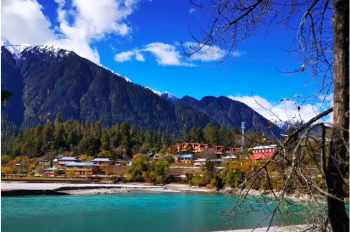Bakha Sangngak Chöling: Difference between revisions
Yeshedorje (talk | contribs) (Created page with "thumb|350px| Bakha Sangngak Chöling '''Bakha Sangngak Chöling''' (Tib. སྦ་ཁ་གསང་སྔགས་ཆོས་གླ...") |
mNo edit summary |
||
| (One intermediate revision by one other user not shown) | |||
| Line 1: | Line 1: | ||
[[Image: Bakha Sangngak Chöling 02.png|thumb|350px| Bakha Sangngak Chöling]] | [[Image: Bakha Sangngak Chöling 02.png|thumb|350px| Bakha Sangngak Chöling]] | ||
'''Bakha Sangngak Chöling''' (Tib. སྦ་ཁ་གསང་སྔགས་ཆོས་གླིང་, Wyl. ''sba kha gsang sngags chos gling'') is a an important [[Nyingma]] monastery in [[Powo]]. It is under the direction of [[Bhakha Tulku Rinpoche]], | '''Bakha Sangngak Chöling''' (Tib. སྦ་ཁ་གསང་སྔགས་ཆོས་གླིང་, [[Wyl.]] ''sba kha gsang sngags chos gling'') is a an important [[Nyingma]] monastery in [[Powo]], Tibet. It is under the direction of [[Bhakha Tulku Rinpoche]], the tenth incarnation in the Bhakha Tulku line. | ||
==Location== | ==Location== | ||
Bakha Sangngak Chöling lies close to the town of [[Kanam]] in Powo, on the southern side of the [[Parlung Tsangpo]].<Ref>It is located between 95° and 96° width and 29° height on map of East Tibet, Gecko Maps, A. Rohweder, Switzerland.</Ref><Ref>Emeric Yeshe Dorje, The History of the Düdjom Tersar Lineage, forthcoming.</Ref> | Bakha Sangngak Chöling lies close to the town of [[Kanam]] in Powo, on the southern side of the [[Parlung Tsangpo]].<Ref>It is located between 95° and 96° width and 29° height on map of East Tibet, Gecko Maps, A. Rohweder, Switzerland.</Ref><Ref>Emeric Yeshe Dorje, ''The History of the Düdjom Tersar Lineage'', forthcoming.</Ref> | ||
==Foundation== | ==Foundation== | ||
Legend has it that in the seventh century, Tibet’s reigning emperor, [[Songtsen Gampo]], had sent his most trusted minister to escort his Chinese bride Wengcheng Kongjo from the Tang dynasty court. They fell in love, and the minister conspired to take the most circuitous route back to Lhasa as possible. As they entered the Powo valley, the princess gave birth to their stillborn child and consulted geomantic texts to determine the most auspicious burial site. Centuries later, Bakha (Burial Ground) monastery was built at the site of the grave.<Ref>Phurbu rdo rje (1988), sPo bo lo rgyus, [History of Powo], Lhasa: bod ljongs mi dmangs dpe skrun khang.</Ref> | Legend has it that in the seventh century, Tibet’s reigning emperor, [[Songtsen Gampo]], had sent his most trusted minister to escort his Chinese bride Wengcheng Kongjo from the Tang dynasty court. They fell in love, and the minister conspired to take the most circuitous route back to [[Lhasa]] as possible. As they entered the Powo valley, the princess gave birth to their stillborn child and consulted geomantic texts to determine the most auspicious burial site. Centuries later, Bakha (Burial Ground) monastery was built at the site of the grave.<Ref>Phurbu rdo rje (1988), sPo bo lo rgyus, [History of Powo], Lhasa: bod ljongs mi dmangs dpe skrun khang.</Ref> | ||
The first Bakha Tulku, Rigdzin Yangdak Gyatso (Wyl. rig ‘dzin yang dag rgya mtsho) was born in Nyemo, Central Tibet and became personal teacher to the Kanam Depa of Powo of that time. Thus, Bakha Sangngak Chöling, a predominantly Nyingma monastery, was established. | The first Bakha Tulku, Rigdzin Yangdak Gyatso (Wyl. rig ‘dzin yang dag rgya mtsho) was born in Nyemo, Central Tibet and became personal teacher to the Kanam Depa of Powo of that time. Thus, Bakha Sangngak Chöling, a predominantly Nyingma monastery, was established. | ||
| Line 31: | Line 31: | ||
<small><references/></small> | <small><references/></small> | ||
[[Category:Tibet]] | |||
[[Category: Tibet]] | |||
[[Category:Powo]] | [[Category:Powo]] | ||
[[Category:Nyingma Monasteries]] | [[Category:Nyingma Monasteries]] | ||
Latest revision as of 20:16, 25 March 2021

Bakha Sangngak Chöling (Tib. སྦ་ཁ་གསང་སྔགས་ཆོས་གླིང་, Wyl. sba kha gsang sngags chos gling) is a an important Nyingma monastery in Powo, Tibet. It is under the direction of Bhakha Tulku Rinpoche, the tenth incarnation in the Bhakha Tulku line.
Location
Bakha Sangngak Chöling lies close to the town of Kanam in Powo, on the southern side of the Parlung Tsangpo.[1][2]
Foundation
Legend has it that in the seventh century, Tibet’s reigning emperor, Songtsen Gampo, had sent his most trusted minister to escort his Chinese bride Wengcheng Kongjo from the Tang dynasty court. They fell in love, and the minister conspired to take the most circuitous route back to Lhasa as possible. As they entered the Powo valley, the princess gave birth to their stillborn child and consulted geomantic texts to determine the most auspicious burial site. Centuries later, Bakha (Burial Ground) monastery was built at the site of the grave.[3] The first Bakha Tulku, Rigdzin Yangdak Gyatso (Wyl. rig ‘dzin yang dag rgya mtsho) was born in Nyemo, Central Tibet and became personal teacher to the Kanam Depa of Powo of that time. Thus, Bakha Sangngak Chöling, a predominantly Nyingma monastery, was established.
Description
Bakha Sangngak Chöling is located with the village of Bakha.
Developments
Over several centuries, the successive Kanam Depa of Powo acted as a sponsor for the monastery.[4]
Main Linages
The main terma lineages held at Bakha Sangngak Chöling were the following:
Main Teachers
The main incarnation line is the Bakha Tuklku, with ten incarnations up to now. They are seen as incarnations of Vairotsana and Pema Lingpa. The present incarnation, Bhakha Tulku Rinpoche (b.1944) was recognized by the Sixteenth Karmapa, Karmapa Rangjung Rigpé Dorje, in Tsurphu Monastery, and this recognition was also confirmed by Dudjom Rinpoche.
Recent Years
Bakha monastery has been destroyed during the political events of the 1960’s but has been rebuild under the guidance of the present Bakha Tulku.
Notes
- ↑ It is located between 95° and 96° width and 29° height on map of East Tibet, Gecko Maps, A. Rohweder, Switzerland.
- ↑ Emeric Yeshe Dorje, The History of the Düdjom Tersar Lineage, forthcoming.
- ↑ Phurbu rdo rje (1988), sPo bo lo rgyus, [History of Powo], Lhasa: bod ljongs mi dmangs dpe skrun khang.
- ↑ Schwieger, Peter (2002): A Preliminary Historical Outline of the Royal Dynasty of sPo-bo, in: Tractata Tibetica et Mongolica. Festschrift für Klaus Sagaster zum 65. Geburtstag. Wiesbaden, p. 223.